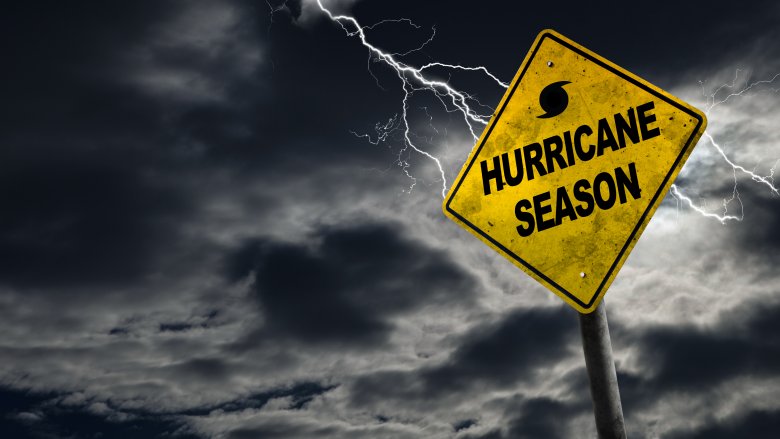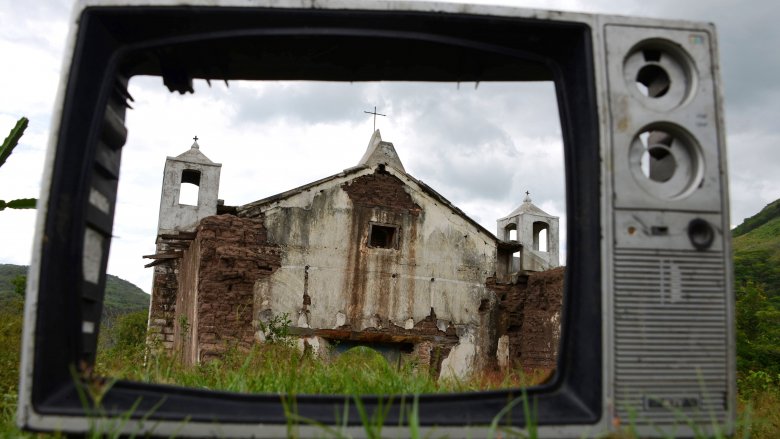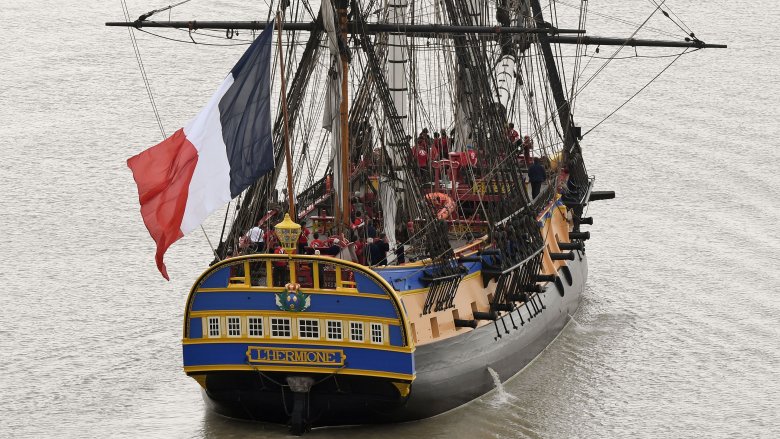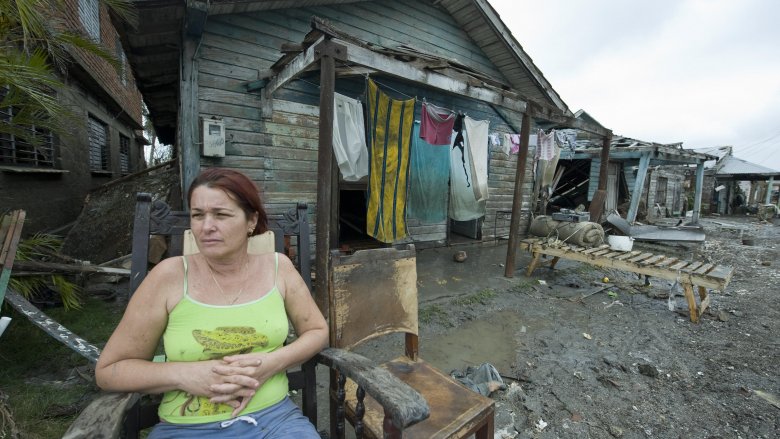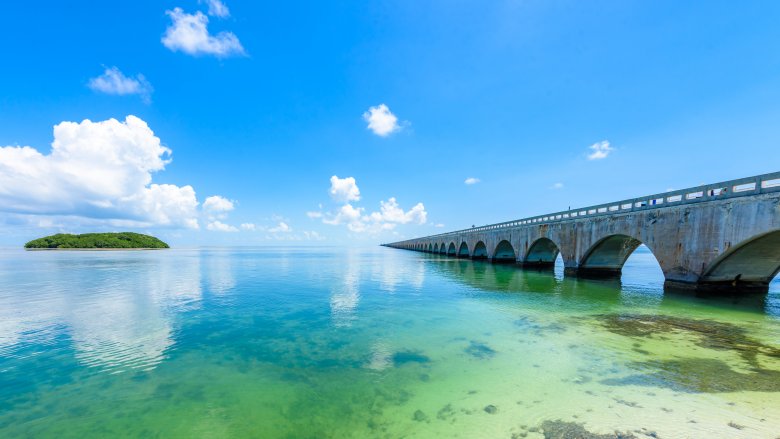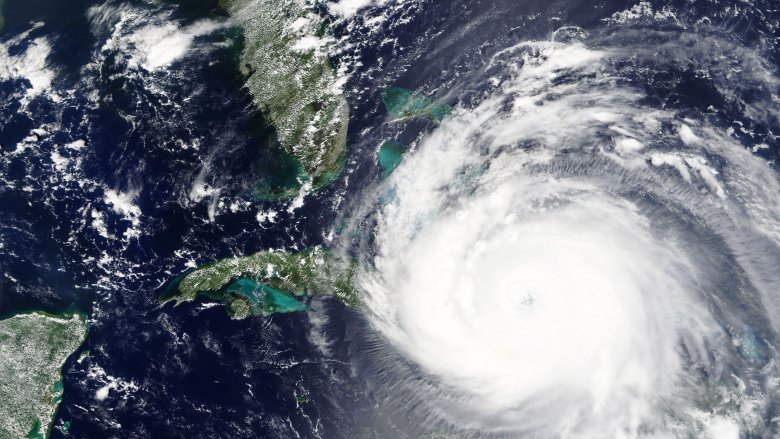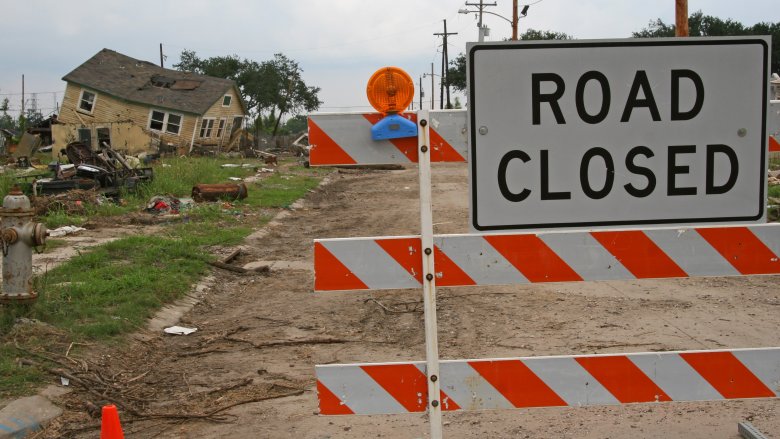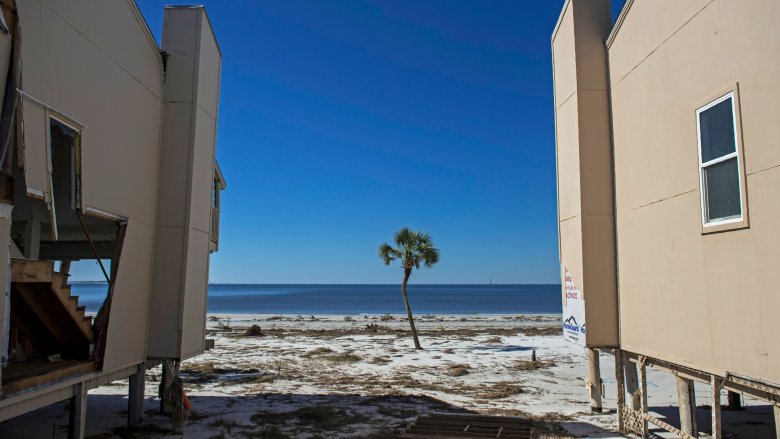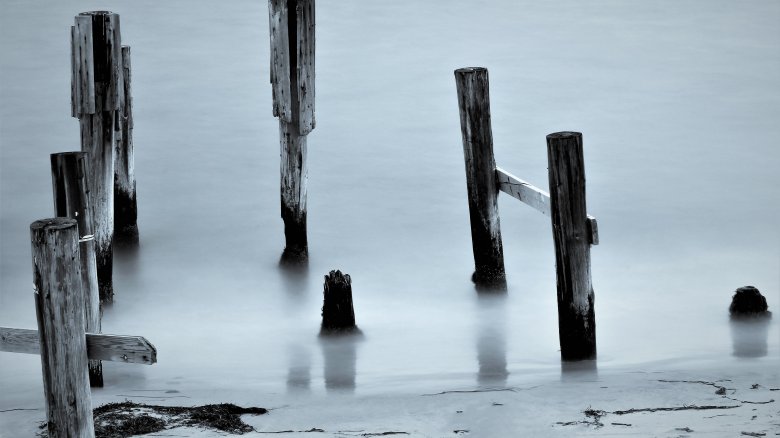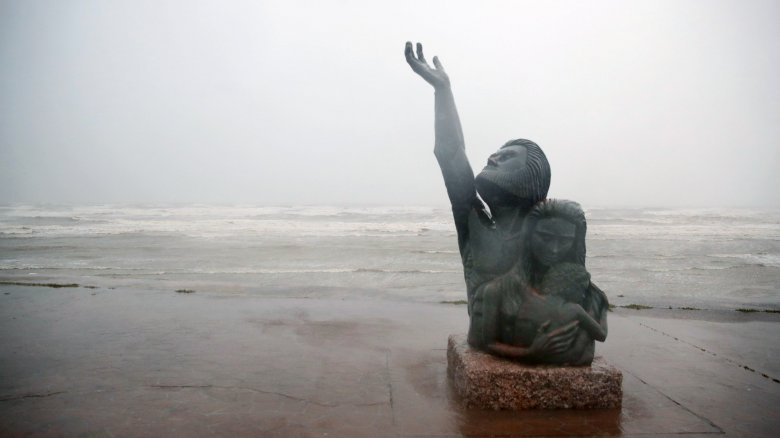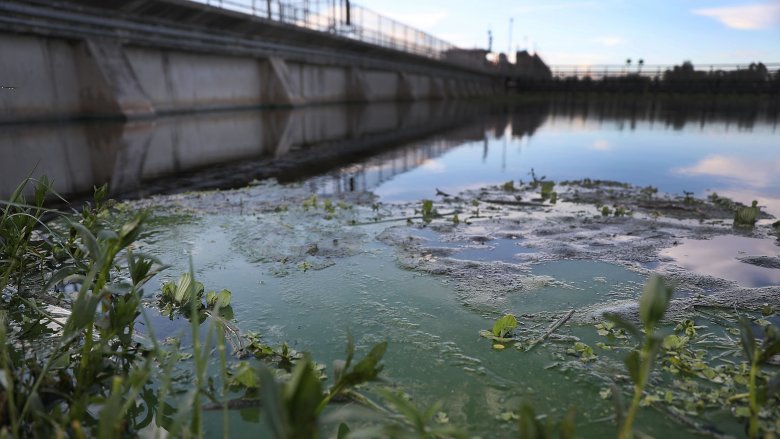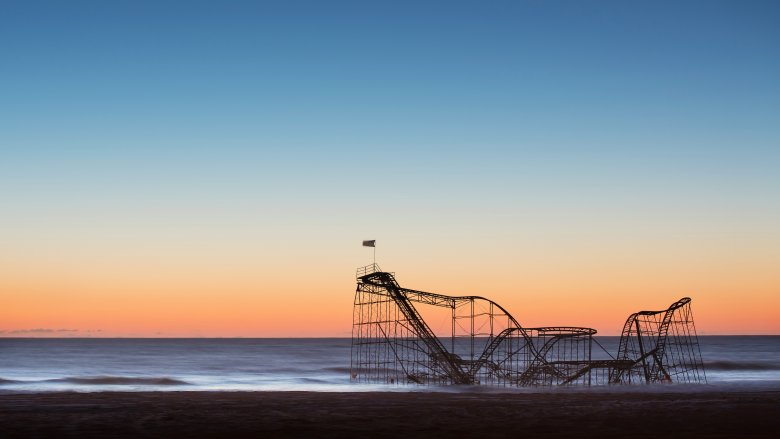The Most Devastating Hurricanes Throughout History
Hollywood loves a good disaster movie. Real weather disasters can be just as dramatic, but far less entertaining. Every so often, Mother Nature decides to remind the people living on her planet just how powerful she can be, and in the 21st Century, she's apparently decided mankind needs a very, very stern lesson. Hurricanes have been in the news a lot in recent years, and according to The Guardian, they really are getting worse. The National Hurricane Center keeps track of all the major named storms that ravage the country, and while 2005 was a record year with 28 named storms, the overall trend is clearly on the rise.
Earth System Research Laboratory has compiled data on how powerful these storms are and how long they last. Between 1994 and 2018 (that's 24 years), there have been 16 years in which hurricane seasons were considered "above normal." Given that they're directly impacted by ocean temperature and that's also on the rise, it's safe to say the world can expect to see more devastating hurricanes — like these.
The last dance
The short history of Louisiana's Isle Derniere started in 1840, when a group of wealthy families decided to build around 100 summer homes on the 24-mile-long island off the coast. The Smithsonian says it was paradise, a place where visitors could go to paddle boat and picnic during the day, then dance the night away in the town's ballroom. This idyllic lifestyle came to an end on August 10, 1856, when a ball was interrupted by billowing winds that heralded death for around half of the island's 400-odd residents.
The summer vacationers had little warning. According to eyewitness reports, the waters started looking dark on August 8, but most were unconcerned. The next day, the animals were restless, the waves were crashing, and some left for the mainland on a steamboat ferry. The captain had time to return to the island — a decision that saved lives — before the hurricane hit. Today, weather services would label it a Category 4 storm, with 150 mph winds that destroyed everything but a stable.
Some took refuge in the stable, and some survived by clinging to debris after being washed out to sea. The ferry didn't have time to evacuate more people, but did manage to stay afloat and provide shelter for some. The hurricane didn't just destroy buildings and people — it divided the island in half. Subsequent storms did more damage, and by 1988, just 22 percent of Derniere's land mass remained above water. Now, it's only home to birds.
Devastation in Central America
Hurricane Mitch was a tropical depression when it first showed up on the radar in 1998. By the time it hit Central America, it was a Category 5 hurricane with wind gusts up to 200 mph. According to The History Channel, the death toll is impossible to determine. Experts put it somewhere between 11,000 and 18,000 dead, including 2,000 people who died not in the hurricane itself, but in a massive mudslide caused by the storm.
According to the San Pedro Sun, thousands of people were evacuated as the storm neared. Others were left behind, when the hurricane came too quickly and closed all potential escape routes. Belize was never formerly ordered to evacuate, in part due to the highly irregular and unpredictable path Mitch took.
Wind speeds dropped by the time Mitch made landfall, but there was another problem: torrential rains. Many areas were drowned with more than a year's worth of rain in hours, and a number of the deaths were due to flash floods and landslides. According to a study in the Natural Hazards Review, more than 6.7 million people were affected, and by the time the hurricane moved on, it had done a staggering $8.5 billion in damage.
The deadliest hurricane in the Western Hemisphere
The National Hurricane Center describes a Category 5 hurricane as one with winds higher than 157 miles per hour, where "catastrophic damage will occur." The deadliest hurricane ever to hit the Western Hemisphere predates that scale by a few hundred years, but with sustained winds of more than 200 mph, it would have been off the chart.
The History Channel says the Great Hurricane of 1780 swept across — and destroyed — Barbados first, so violent that eyewitnesses were unable to hear their own shouts. Historical accounts (via Britannica) say everything on the island was simply gone, save a few trees. From there, it moved on across Martinique, Guadeloupe, Puerto Rico, Mona, and the Dominican Republic. Storms lasted for around a week, says New Historian, and by the time it was over somewhere, between 20,000 and 22,000 people were dead.
It also impacted the course of a major historical event: the American Revolution. On the eve of the storm, dozens of warships on both sides of the conflict were waiting to be dispatched to the north and enter the fray. The death toll includes thousands who died on sinking military vessels, including 40 French ships and an entire British fleet stationed off of St. Lucia. Even after the worst of the hurricane was over, it cut across the path of major shipping routes, destroying still more ships heading home to Europe.
The price of evacuation
According to the National Oceanic and Atmospheric Administration, the hurricane that hit Cuba in 1932 would now be classified as a Category 4, and the estimated death toll of around 3,500 makes it one of the deadliest hurricanes on record. While the Miami Herald reported that warning of the imminent hurricane traveled by telegram, survivors told Radio Cadena Agramonte harrowing tales of waiting for help that would be too late.
Josefa Canete Esquedulo and her husband lost siblings and grandparents in the hurricane, and said a delayed response from their government had a lot to do with the deaths. "Many families took refuge in the empty railroad freight cars, but some of them were locked, and the wind turned them over," she remembered. "Hundreds of people died stuck in there."
Survivors waited a long time for answers as to just why help was so late in arriving, and a heartbreaking explanation came from the nephew of Cuban railway engineer Rafael Olegario Marin Placeres. He claimed the trains were ready and waiting to go, but the American owners of the company had demanded $500 from Santa Cruz del Sur before they would head in to evacuate the town. By the time the trains got there, they were too late. Decades later, the same area was devastated again by Hurricane Irma.
The Labor Day Hurricane of 1935
On September 2, 1935, the most intense storm ever to make landfall in the U.S. swept across the Florida Keys. There were around 1,000 people on the Keys when the hurricane hit, and almost half died in the storm. To add to the tragedy, Dr. Ben Brotemarkle of the Florida Historical Society says (via Florida Today) that as many as 150 of the dead were veterans of World War I who had been given jobs working on government road construction.
National Geographic says the devastating loss of life was essentially down to a single misunderstanding. The two men overseeing construction were stretched to their limits, supervising a crew already suffering from PTSD (or "shell shock," as they called it then). They knew hurricanes were a very real possibility, and made arrangements to have a train ready and waiting to evacuate the men if needed. But there was a miscommunication, and supervisors didn't know it would take those trains several hours to be ready to run.
The delay proved deadly. By the time the fledgling meteorological service realized the danger and supervisors finally admitted it was time to evacuate, it was too late. The train sped to the rescue, only be thrown from the tracks as the hurricane swept through the workers' camps. It was a national outrage at the time, ultimately deemed "an act of God."
The hurricane that nearly destroyed a blossoming city
When a Category 4 hurricane hit Miami in 1926, the city had a population of around 100,000, and was full of new residents and new construction. The National Weather Service says the hurricane left 372 people dead, 6,000 injured, and $105 million in damages (the equivalent of more than $164 billion today).
When the Miami Herald looked back on the storm and the tragedy it brought, they concluded that a huge part of the problem was the sheer number of new residents who had no idea how hurricanes worked. When the eye of the storm passed, residents thought it was over and flooded into the streets to assess the damage. Richard Gray, the city's meteorologist, tried to warn people, but few listened. Ultimately, most of the deaths would come during the hurricane's inevitable second act.
It didn't help that hurricane warnings were issued late at night, when most were sleeping, and the eye arrived with daybreak. Around 43,000 people were left homeless and 200 children were separated from their families, sent to an emergency shelter. The aftermath was so dire that martial law was invoked to protect the dwindling food supplies. The city was rebuilt quickly, historians say, once the most immediate health concern was taken care of: the bodies of the dead.
Hurricane Katrina
When Katrina made landfall in 2005, it devastated entire areas, killed 1,833 people, left hundreds of thousands homeless, caused an estimated $125 billion in damages, and almost destroyed New Orleans (via CNN). It's one of the costliest natural disasters in America's history. The sheer scale is difficult to comprehend.
Thanks to national news and social media, Katrina was well-documented. The storm itself was just the beginning of the story for countless people like Kenyon Dunbar. He was 14 when he and his family fled the hurricane, settling briefly in California and eventually returning home 18 months after the storm. Rolling Stone talked to him ten years later, and he spoke of the darkness that hung over the city and the face of a little dead girl he still saw in his dreams. "We were almost the first people back. It was a ghost town," Dunbar recalled. "You could smell the death. You could smell the mold. It was on everything."
Developmental psychologists were only then getting to see the impact the disaster had on those who lived through it as children, and it was as devastating. Around 160,000 children were displaced by Katrina, some separated from their families, and moved an average of seven times. A decade later, Louisiana had one of the highest rates of unemployed young adults who dropped out of school, thought to be a direct consequence of Katrina.
Florida's deadly mistakes exposed
Hurricane Andrew hit Florida in 1992, and was a deadly reminder of how much science still had to learn. When the storm first started gathering in the Atlantic, meteorologists didn't pay much attention (via AccuWeather). They thought it was going to disappear, and that was in mid-August. By August 22, it was a fully developed Category 5 hurricane heading for Florida, and the worst news? Residents in the path had only a day's warning.
According to USA Today, 15 people died in the storm, and 25 in the aftermath. More than 25,000 homes were destroyed and another 100,000 were damaged, and the following months were complete chaos. Thousands of families fled even as the military arrived to restore peace amid the looting. A number of aviaries and zoos were also destroyed, sending panicked animals — including cougars and vipers — out into the stricken streets.
The chaotic aftermath of the storm also did something else: it shed light on weaknesses in the system the federal government had set up to deal with exactly this sort of thing, and it also exposed massive holes in the state's building codes. These systems got a complete overhaul post-Andrew, but many survivors left and never returned to see the changes the devastation had brought.
Sandy's deadly, terrifying predecessor
New England Today sets a terrifying scene. The summer of 1938 had been miserable, so when the sun shone and the warm breeze blew in on September 21, families were hopeful for at least one last hurrah. Boats headed out, families hit the beach, and some even returned to the cottages they'd already left for the season.
But Bill Cawley, a reporter for the Westerly Sun, wrote that he had "an eerie feeling... something in the air, like a kind of suspension was about to end." It did, and it started when the sky turned yellow. By 2 pm, fishermen were marveling at the bank of fog rolling in from the ocean. It wasn't until it was too late that they realized it wasn't fog, it was water. The hurricane — and 200 mph winds — hit fast. The storm moved at 60 mph, flattening houses and killing as it went. The hurricane moved on and the sun rose the next morning before any outside help arrived.
The New England Historical Society says the death toll was somewhere between 400 and 800. It was so powerful that it permanently altered the coastline, destroyed 20,000 miles of telephone and power lines, and pushed massive ships on shore and through buildings. Other buildings were torn off their foundations, including the home of the Moore family of Rhode Island. Miraculously, they clung to the floor until the remnants of their house washed ashore in Connecticut and survived to tell the tale.
The hurricanes of Galveston
Galveston, Texas, has been the site of some devastating hurricanes. In 2017, Harvey made landfall just shy of 200 miles from the coastal city (via Forbes). In 1961, KTRK-TV reported on Carla's destruction of a huge section of the Texas coastline. In addition to the hurricane's extensive damage, it also spawned 26 tornadoes. One headed to Galveston, destroyed 120 buildings, and killed six people. As tragic as that was, it pales in comparison to the destruction brought down on the city on September 8, 1900.
The death toll, says The History Channel, was somewhere between 6,000 and 12,000, and more than 3,600 buildings were destroyed. Perhaps worst of all, those deaths might have been avoided. Despite the fact that meteorologists in Cuba knew there was a hurricane heading toward the U.S., the Washington, D.C. Weather Bureau predicted the hurricane would hit Florida and head up the Atlantic Coast. They could hardly have been more wrong, and for a terrible reason.
The Weather Bureau (which would later become the National Weather Service) was still in its infancy, and saw Cuba's weather forecasting team as rivals. They severed communications with Cuba, then instructed satellite offices not to issue warnings without going through D.C. The result was a delayed warning regarding a storm that killed thousands.
Burning the bodies where they drowned
In September 1928, a storm Environment & Society calls one of the worst in the history of the U.S. hit Puerto Rico, the Virgin Islands, the Bahamas, and Florida. As many as 1,000 people had already died by the time it passed over Lake Okeechobee, but this Florida region was hardest hit for a heartbreaking reason.
The lake was surrounded by fertile croplands, and when the hurricane hit, winds and rains flooded the area and people drowned where they worked. The death toll in that area alone was somewhere between 2,000 and 3,000, and there were so many bodies they were burned in situ, because many had started decomposing before they could be properly tended to. Many were migrant workers from the Bahamas.
Meteorologist Wayne Neely told National Geographic that the slow-moving hurricane pummeled the areas it passed over for 18 hours, damaging more than 200,000 homes and destroying almost all the year's crops. He does say, though, that something good came of it. The Herbert Hoover Dike was built around the lake to prevent future flooding, and it's the same sort of protective measure now found at countless other lakes.
Crawling up the East Coast
Sandy's 2012 crawl through the Caribbean and up the East Coast of the U.S. marked a horrifying few days. By the time it was over, it had directly impacted 24 states and caused $71 billion in damages. Starting as a Category 1 hurricane in the Caribbean, CNN says Sandy was actually downgraded to a tropical storm on October 27, the same day that New Jersey, Connecticut, and Massachusetts declared a state of emergency. The National Guard was mobilized the following day, and on the 29th, it made landfall as a Category 2 hurricane.
Power outages impacted around 7.9 million business and homes. Destruction was widespread and complete. It was so complete that five years later, The Guardian checked in with those who had been living in Sandy's path and found that one in five people were still waiting for repairs to be completed.
New York City launched "Build it Back," an initiative dedicated to ensuring that future hurricanes would be less destructive than Sandy. The program was responsible for doing things like raising some buildings as much as nine feet, but red tape kept countless families in a horrible limbo. Safeguards have been installed in New York City's subway systems and anti-flooding bulkheads, but proposed cuts to funding once slated to help protect cities against the effects of climate change have experts wondering if Sandy was only the beginning.
